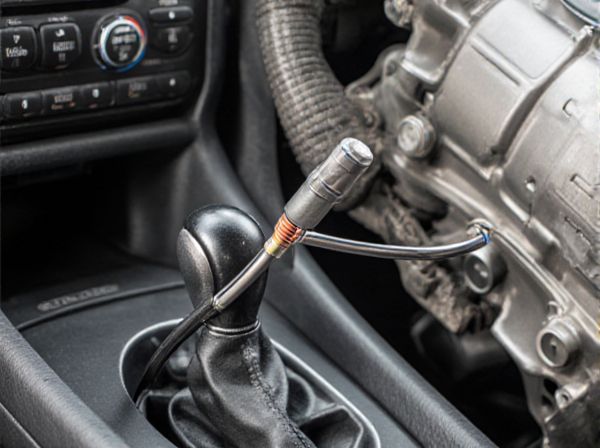
Photo illustration: Shift-by-wire vs Cable-actuated
Shift-by-wire systems offer precise and reliable gear changes by electronically controlling the transmission, eliminating the need for traditional mechanical linkages found in cable-actuated setups. Your vehicle benefits from reduced weight, improved interior design flexibility, and faster response times with shift-by-wire technology. While cable-actuated systems rely on physical cables that may experience wear and require maintenance, shift-by-wire enhances overall driving performance and durability.
Table of Comparison
| Feature | Shift-by-Wire Transmission | Cable-Actuated Transmission |
|---|---|---|
| Mechanism | Electronic control system, no mechanical linkage | Mechanical cables physically connecting shifter to transmission |
| Response Time | Faster, precise, immediate gear changes | Slower due to mechanical movement and cable slack |
| Reliability | Dependence on electronics, may require software updates | Proven mechanical reliability, susceptible to cable wear |
| Maintenance | Minimal mechanical wear, requires electronic diagnostics | Regular cable inspection and adjustment needed |
| Installation Complexity | Requires integration with vehicle electronic systems | Simpler mechanical installation |
| Cost | Higher initial cost due to advanced technology | Lower cost, traditional design |
| Design Flexibility | Compact layout, more interior design options | Limited by cable routing requirements |
| Safety Features | Enhanced with electronic interlocks and fail-safes | Basic mechanical safety, fewer interlocks |
Introduction to Gear Shifting Technologies
Shift-by-wire systems replace traditional mechanical linkages with electronic controls, enabling precise and rapid gear changes through sensors and actuators. Cable-actuated gear shifting relies on physical cables to mechanically connect the gear lever to the transmission, offering a direct tactile response familiar in conventional vehicles. Innovations in shift-by-wire technology enhance vehicle performance and integration with advanced driver assistance systems, while cable-actuated mechanisms remain valued for simplicity and reliability in many automotive applications.
What is Shift-by-Wire?
Shift-by-wire is an advanced automotive technology that replaces traditional mechanical linkages in gear shifting with electronic controls, enabling smoother and faster gear changes. This system uses sensors and actuators to electronically transmit driver input to the transmission, enhancing precision and reducing physical wear. Shift-by-wire also supports integration with modern driver assistance systems and allows for more flexible interior design layouts in vehicles.
Understanding Cable-Actuated Systems
Cable-actuated systems use mechanical cables to transmit driver input from the gear lever to the transmission, providing a direct and tactile connection. These systems rely on flexible steel cables housed within protective sheaths, allowing for smooth and precise shifting while minimizing transmission effort. Their simplicity and reliability make cable-actuated linkages a popular choice in many traditional manual and automatic transmissions.
Key Differences Between Shift-by-Wire and Cable-Actuated
Shift-by-wire systems replace traditional mechanical linkages with electronic controls, allowing gear selection through electronic signals rather than physical cables. Cable-actuated mechanisms rely on direct mechanical connections, using cables to transmit driver input from the shifter to the transmission. Key differences include reduced mechanical wear and increased design flexibility with shift-by-wire, contrasted by the simplicity and lower cost of cable-actuated systems.
Performance and Responsiveness Comparison
Shift-by-wire systems deliver superior performance and responsiveness compared to cable-actuated mechanisms by utilizing electronic signals for gear changes, enabling faster and smoother shifts. Cable-actuated systems rely on mechanical linkages that can introduce latency and require more physical effort, leading to less precise gear engagement. Enhanced precision in shift-by-wire technology reduces shift times and improves overall driving experience, making it the preferred choice in modern vehicles.
Reliability and Maintenance Considerations
Shift-by-wire systems offer enhanced reliability due to fewer mechanical components prone to wear, reducing the risk of cable stretching or snapping common in cable-actuated designs. Maintenance demands for shift-by-wire are generally lower as electronic sensors and actuators require less frequent adjustment compared to the periodic cable tension checks and lubrication needed in cable-actuated systems. However, shift-by-wire relies heavily on electronic diagnostics and software integrity, necessitating specialized tools and expertise for troubleshooting, whereas cable-actuated mechanisms are simpler to inspect and repair with basic mechanical skills.
Safety Features and Fail-safes
Shift-by-wire systems enhance safety by eliminating mechanical linkages, reducing the risk of gear misalignment and increasing precision with electronic control units that monitor and adjust gear shifts in real time. Fail-safes in shift-by-wire include automatic park engagement upon engine shutdown or system failure, preventing unintended vehicle movement and enabling override modes for driver control. In contrast, cable-actuated systems rely on physical connections prone to wear and cable breakage, lacking advanced electronic fail-safes but often feature mechanical interlocks to prevent accidental gear shifts.
Integration with Modern Vehicle Technology
Shift-by-wire systems offer seamless integration with advanced driver assistance systems (ADAS) and autonomous driving technologies by enabling electronic control and feedback, unlike cable-actuated mechanisms which rely on mechanical linkages. The electronic nature of shift-by-wire supports features such as programmable shift patterns, fail-safe protocols, and enhanced connectivity with vehicle sensors and control units. This integration facilitates smoother operation, real-time diagnostics, and compatibility with digital interfaces, making shift-by-wire preferable for modern vehicles embracing smart and autonomous functionalities.
Cost Implications for Manufacturers and Consumers
Shift-by-wire systems reduce manufacturing costs by eliminating mechanical linkages, lowering assembly complexity and maintenance needs compared to cable-actuated counterparts. Consumers benefit from increased reliability and smoother gear transitions, although initial vehicle prices may be higher due to advanced electronic components. Over time, the decreased maintenance expenses and improved durability of shift-by-wire systems can offset the upfront cost differences for both manufacturers and buyers.
Future Trends in Gear Shifting Systems
Shift-by-wire technology is rapidly advancing, integrating electronic controls to replace traditional mechanical linkages, resulting in faster, more precise gear changes and reduced vehicle weight. Future trends emphasize seamless connectivity with autonomous driving systems and enhanced cybersecurity measures to prevent hacking threats. Innovations in cable-actuated systems focus on lightweight materials and improved ergonomics, but the shift-by-wire approach dominates the market due to its compatibility with electric and hybrid vehicles, supporting the evolution toward smarter, more efficient gear shifting solutions.
 caratoz.com
caratoz.com